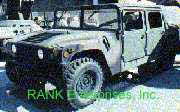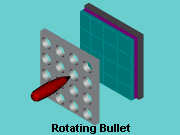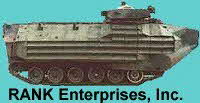|
RANK Enterprises, Inc. specializes in armor to protect vehicles against kinetic threats of up to 30 mm Armor Piercing (the British made RARDEN round) and up to a TOW sized anti tank shaped charge missile. Reactive armor is described on a separate page.
Several technologies were developed by RANK Enterprises to improve the armor protection of fairly well known materials. These technologies can be roughly divided into several categories:
Fiber Based Composites
This group includes both flexible and rigid armor plates made of combinations of fibers. A very efficient composite is, for example, a plate made of S glass, Modified Polypropylene and Nylon. This armor offers an excellent combination of high weight efficiency, capability to stop both fragments and FMJ projectiles at high velocities and AP projectiles at somewhat lower velocities. It is
approximately 3 times more effective than S glass alone, and compares well with composites based on Aramide fibers (such as Kevlar®) at a fraction of their cost.
RANK Enterprises, Inc. has developed other combination composites, that are tuned to specific needs, and is ready to apply its expertise to provide the best solution to its customers problems.
Ceramic composites
RANK Enterprises has developed several novel ceramic composites. For example: a non homogenous ceramic body containing boron carbide or silicon carbide in an aluminum oxide matrix. This composite, though more expensive than aluminum oxide, is much more efficient in defeating armor piercing projectiles. It is also much less expensive than pure boron or silicon carbides.
Hard faced armor
 RANK Enterprises has available a large number of armor designs using ceramic tiles or metal plate (titanium etc.) with backing plates made of composites or metals. All of these designs are more efficient than the classic
aluminum oxide - glass fiber configuration, some by a factor of 1.8 and up to a factor of 3. The kits include mounting hardware specifically designed for the vehicles and according to customers' specifications. RANK Enterprises has available a large number of armor designs using ceramic tiles or metal plate (titanium etc.) with backing plates made of composites or metals. All of these designs are more efficient than the classic
aluminum oxide - glass fiber configuration, some by a factor of 1.8 and up to a factor of 3. The kits include mounting hardware specifically designed for the vehicles and according to customers' specifications.
Similar concepts are also used by us in body armor and aircraft armor designs, with different materials
augmenting each other and providing optimal armor performance.
Hybrid armor
This category of armor includes multilayer designs incorporating spaces and utilizing both the special properties of some materials and the advantages of certain geometries. RANK Enterprises' ability to perform shock wave interference analysis enables us to design highly efficient armor configurations using widely available materials.
For example: perforated steel plate position at a distance from a vehicle's body has been used for some time as a fairly efficient armor element. A simple perforated armor steel plate has several significant weaknesses:
 To be effective this armor has to be highly tuned to a specific projectile diameter
, and even than it is effective only against 50% of the incoming projectiles. To be effective this armor has to be highly tuned to a specific projectile diameter
, and even than it is effective only against 50% of the incoming projectiles.
RANK Enterprises, Inc. has designed an improved configuration, which defeats a range of different projectile types and calibers with no compromise on statistical effects - the percentage of projectiles defeated can be predicted and accounted for in the design.
 Other configurations include a super light all metal design capable of defeating large caliber projectiles. This design relies on special geometry and spacing from the carrying vehicle. It always breaks up the projectile so that
the vehicle's base armor can stop these fragments with no damage to itself. Other configurations include a super light all metal design capable of defeating large caliber projectiles. This design relies on special geometry and spacing from the carrying vehicle. It always breaks up the projectile so that
the vehicle's base armor can stop these fragments with no damage to itself.
|